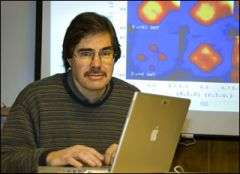Looking for 'Stripes' in High-Tc superconductors

In LBCO, as in all materials, negatively charged electrons repel one another. But by trying to stay as far apart as possible, each individual electron is confined to a limited space, which costs energy. To achieve a lower-energy state, the electrons arrange themselves with their spins aligned in alternating directions on adjacent atoms, a configuration known as antiferromagnetic order.
As mentioned above, scientists can dope the material with electron "holes," or the absence of electrons, to allow the electrons/holes to move more freely and carry current as a superconductor. The question is: How do these holes arrange themselves?
Brookhaven physicist John Tranquada answered that question during his talk about superconducting "stripes" at the March 2007 meeting of the American Physical Society. Studies conducted by Tranquada and other Brookhaven researchers support the controversial theory that the holes segregate themselves into stripes that alternate with antiferromagnetic regions in the material.
"There's a lot of excitement in trying to understand why these materials are superconducting, and there's plenty of controversy surrounding it," Tranquada said.
Most recently, Tranquada's research group examined the effect of the stripes on vibrations in the crystal lattice. Lattice vibrations play a role in pairing up the electrons that carry current in conventional superconductors. At the Laboratorie Leon Brillouin, Saclay, in France, researchers bombarded samples of superconducting materials and the same stripe-ordered non-superconductor with beams of neutrons and measured how the beams scattered.
Comparing the energy and momentum of the incoming beams with those scattered by the samples gives the scientists a measure of how much energy and momentum is transferred to the lattice vibrations. Each of these vibrations normally has a particular, well-defined frequency for a given wavelength. But in the superconductor experiment, at a particular wavelength, the scientists observed an anomaly: a wider range of frequencies in the lattice vibrations.
The scientists observed this anomalous signature most clearly in samples with observable stripe order, but they also saw it in samples of good superconductors without static stripes. This indicates the presence of dynamic stripes - meaning that the stripes can wiggle through the crystal lattice - and suggests that stripes might be important in the mechanism for high-Tc superconductivity, Tranquada said.
Source: BNL




















